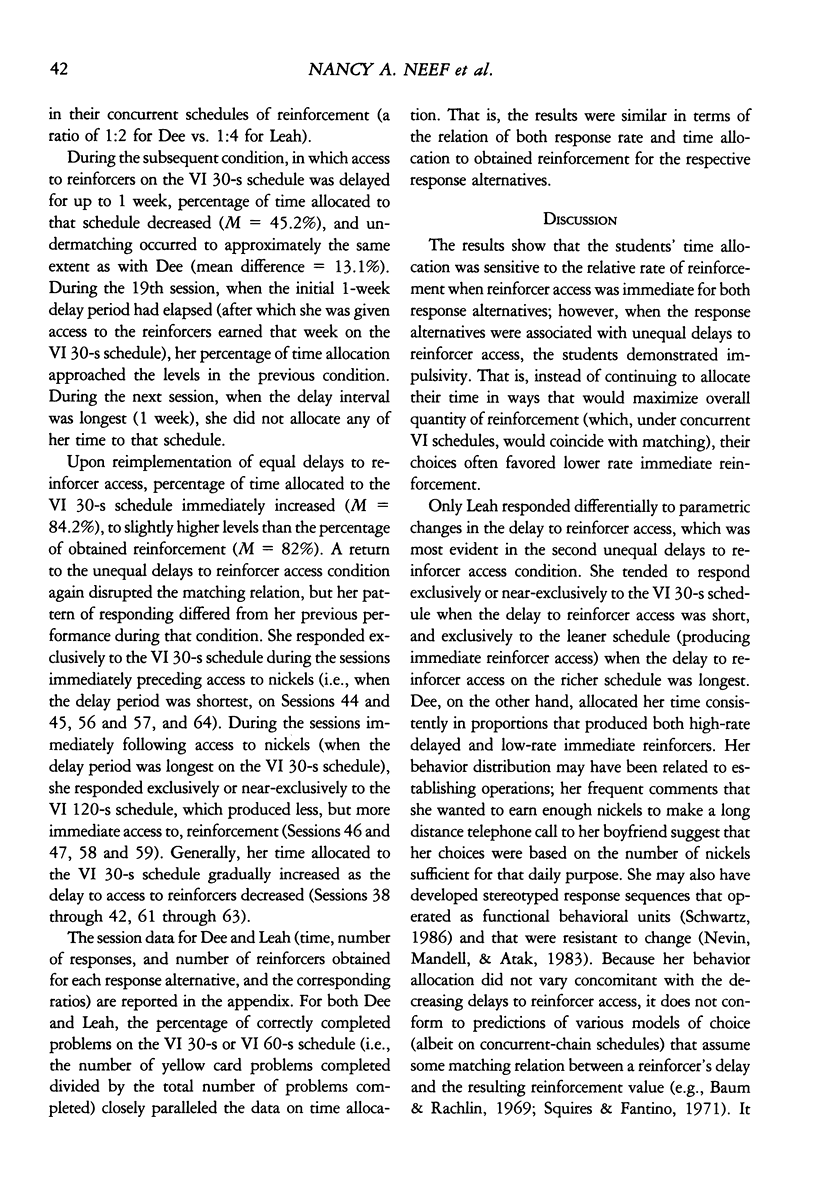Abstract
We conducted two studies extending basic matching research on self-control and impulsivity to the investigation of choices of students diagnosed as seriously emotionally disturbed. In Study 1 we examined the interaction between unequal rates of reinforcement and equal versus unequal delays to reinforcer access on performance of concurrently available sets of math problems. The results of a reversal design showed that when delays to reinforcer access were the same for both response alternatives, the time allocated to each was approximately proportional to obtained reinforcement. When the delays to reinforcer access differed between the response alternatives, there was a bias toward the response alternative and schedule with the lower delays, suggesting impulsivity (i.e., immediate reinforcer access overrode the effects of rate of reinforcement). In Study 2 we examined the interactive effects of reinforcer rate, quality, and delay. Conditions involving delayed access to the high-quality reinforcers on the rich schedule (with immediate access to low-quality reinforcers earned on the lean schedule) were alternated with immediate access to low-quality reinforcers on the rich schedule (with delayed access to high-quality reinforcers on the lean schedule) using a reversal design. With 1 student, reinforcer quality overrode the effects of both reinforcer rate and delay to reinforcer access. The other student tended to respond exclusively to the alternative associated with immediate access to reinforcers. The studies demonstrate a methodology based on matching theory for determining influential dimensions of reinforcers governing individuals' choices.
Full text
PDF















Selected References
These references are in PubMed. This may not be the complete list of references from this article.
- Ainslie G. W. Impulse control in pigeons. J Exp Anal Behav. 1974 May;21(3):485–489. doi: 10.1901/jeab.1974.21-485. [DOI] [PMC free article] [PubMed] [Google Scholar]
- Baum W. M., Rachlin H. C. Choice as time allocation. J Exp Anal Behav. 1969 Nov;12(6):861–874. doi: 10.1901/jeab.1969.12-861. [DOI] [PMC free article] [PubMed] [Google Scholar]
- CATANIA A. C. Concurrent performances: a baseline for the study of reinforcement magnitude. J Exp Anal Behav. 1963 Apr;6:299–300. doi: 10.1901/jeab.1963.6-299. [DOI] [PMC free article] [PubMed] [Google Scholar]
- Chung S. H., Herrnstein R. J. Choice and delay of reinforcement. J Exp Anal Behav. 1967 Jan;10(1):67–74. doi: 10.1901/jeab.1967.10-67. [DOI] [PMC free article] [PubMed] [Google Scholar]
- Cooper L. J., Wacker D. P., Sasso G. M., Reimers T. M., Donn L. K. Using parents as therapists to evaluate appropriate behavior of their children: application to a tertiary diagnostic clinic. J Appl Behav Anal. 1990 Fall;23(3):285–296. doi: 10.1901/jaba.1990.23-285. [DOI] [PMC free article] [PubMed] [Google Scholar]
- Green L., Snyderman M. Choice between rewards differing in amount and delay: Toward a choice model of self control. J Exp Anal Behav. 1980 Sep;34(2):135–147. doi: 10.1901/jeab.1980.34-135. [DOI] [PMC free article] [PubMed] [Google Scholar]
- HERRNSTEIN R. J. Relative and absolute strength of response as a function of frequency of reinforcement. J Exp Anal Behav. 1961 Jul;4:267–272. doi: 10.1901/jeab.1961.4-267. [DOI] [PMC free article] [PubMed] [Google Scholar]
- Horner R. H., Day H. M. The effects of response efficiency on functionally equivalent competing behaviors. J Appl Behav Anal. 1991 Winter;24(4):719–732. doi: 10.1901/jaba.1991.24-719. [DOI] [PMC free article] [PubMed] [Google Scholar]
- Logue A. W., Peña-Correal T. E., Rodriguez M. L., Kabela E. Self-control in adult humans: variation in positive reinforcer amount and delay. J Exp Anal Behav. 1986 Sep;46(2):159–173. doi: 10.1901/jeab.1986.46-159. [DOI] [PMC free article] [PubMed] [Google Scholar]
- Logue A. W., Rodriguez M. L., Peña-Correal T. E., Mauro B. C. Choice in a self-control paradigm: Quantification of experience-based differences. J Exp Anal Behav. 1984 Jan;41(1):53–67. doi: 10.1901/jeab.1984.41-53. [DOI] [PMC free article] [PubMed] [Google Scholar]
- Mazur J. E., Logue A. W. Choice in a "self-control" paradigm: effects of a fading procedure. J Exp Anal Behav. 1978 Jul;30(1):11–17. doi: 10.1901/jeab.1978.30-11. [DOI] [PMC free article] [PubMed] [Google Scholar]
- Neef N. A. Effects of reinforcer rate and reinforcer quality on time allocation: Extensions of matching theory to educational settings. J Appl Behav Anal. 1992 Fall;25(3):691–699. doi: 10.1901/jaba.1992.25-691. [DOI] [PMC free article] [PubMed] [Google Scholar]
- Nevin J. A., Mandell C., Atak J. R. The analysis of behavioral momentum. J Exp Anal Behav. 1983 Jan;39(1):49–59. doi: 10.1901/jeab.1983.39-49. [DOI] [PMC free article] [PubMed] [Google Scholar]
- Schwartz B. Allocation of complex, sequential operants on multiple and concurrent schedules of reinforcement. J Exp Anal Behav. 1986 May;45(3):283–295. doi: 10.1901/jeab.1986.45-283. [DOI] [PMC free article] [PubMed] [Google Scholar]
- Snyderman M. Delay and amount of reward in a concurrent chain. J Exp Anal Behav. 1983 May;39(3):437–447. doi: 10.1901/jeab.1983.39-437. [DOI] [PMC free article] [PubMed] [Google Scholar]
- Squires N., Fantino E. A model for choice in simple concurrent and concurrent-chains schedules. J Exp Anal Behav. 1971 Jan;15(1):27–38. doi: 10.1901/jeab.1971.15-27. [DOI] [PMC free article] [PubMed] [Google Scholar]


